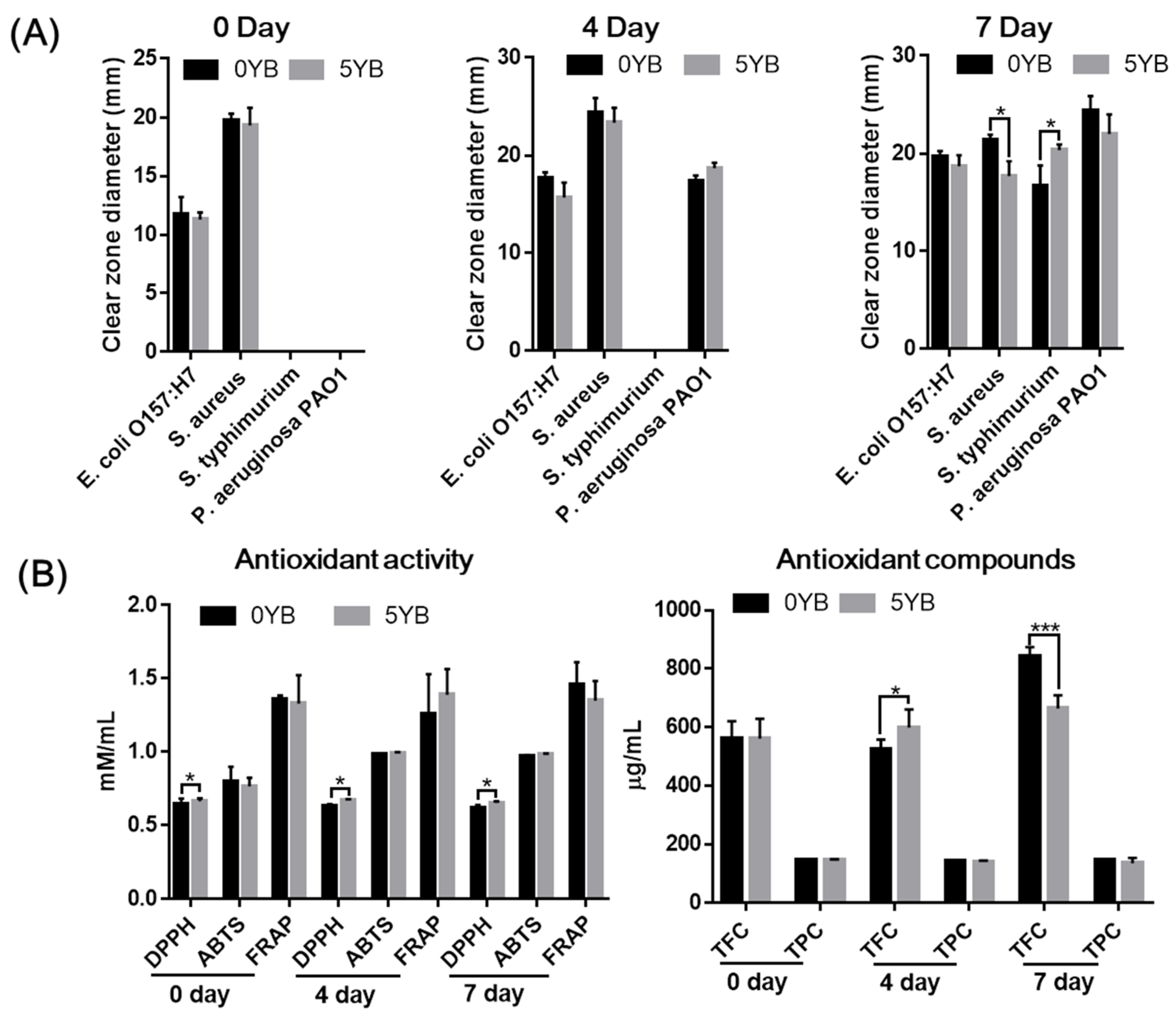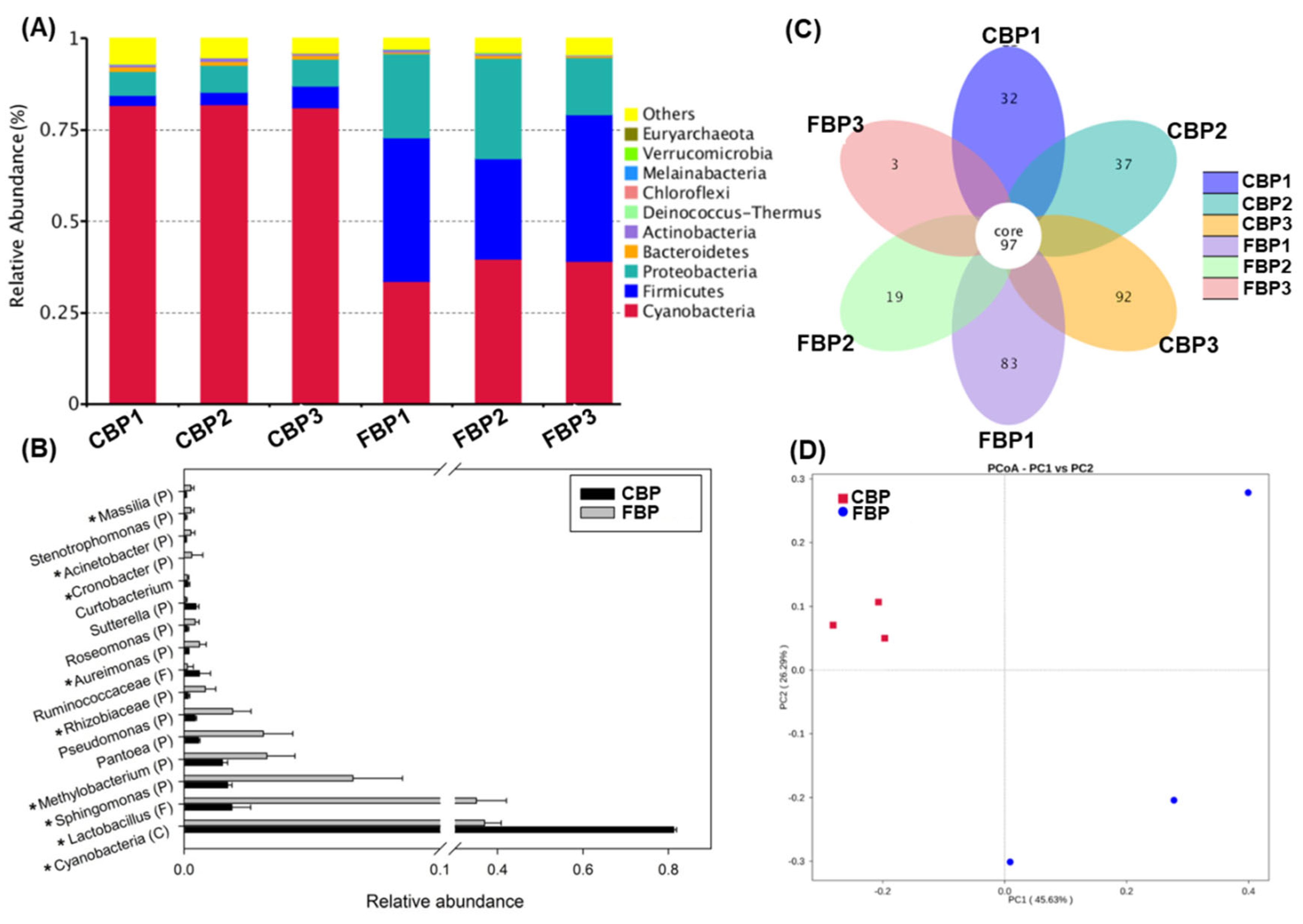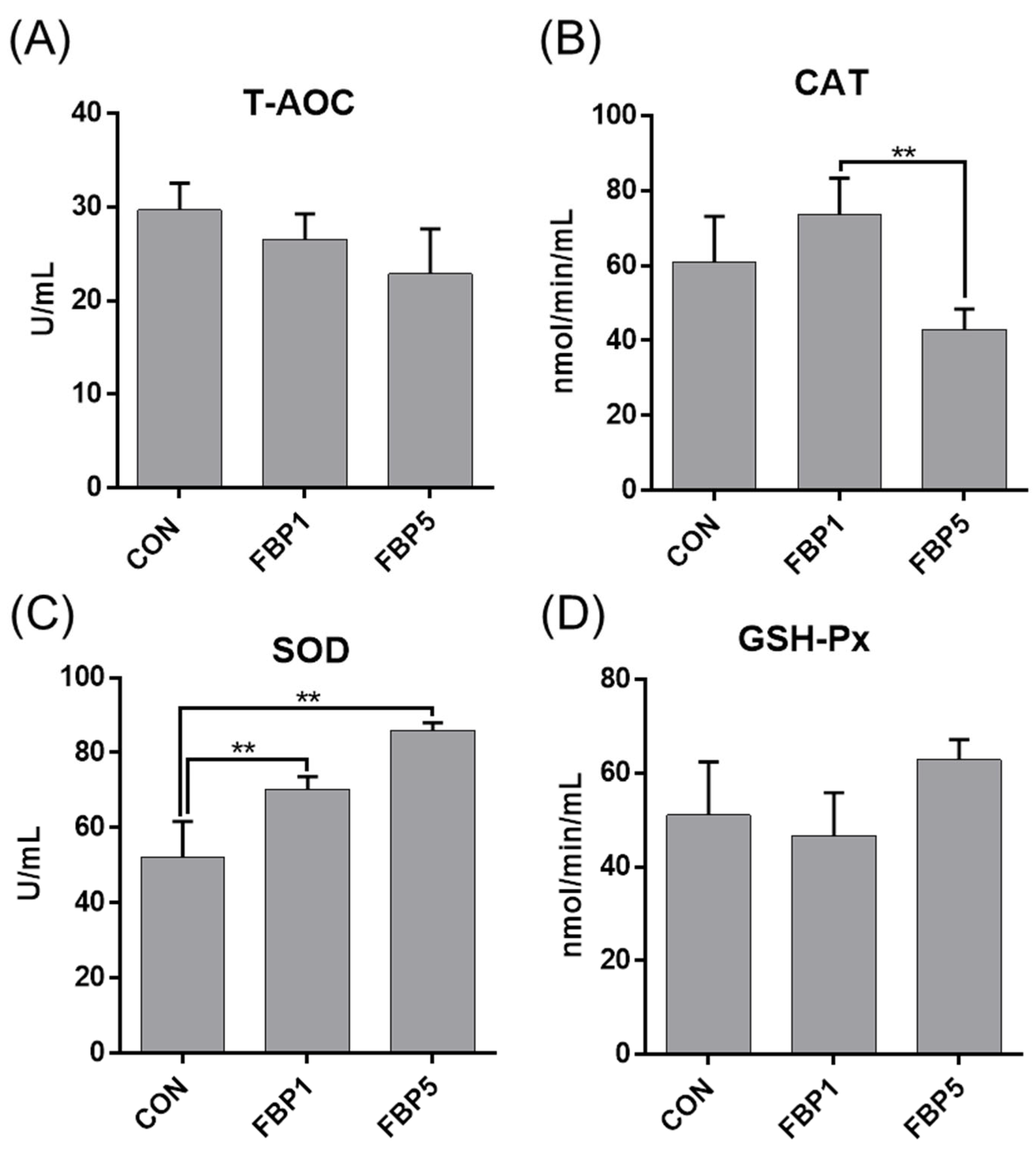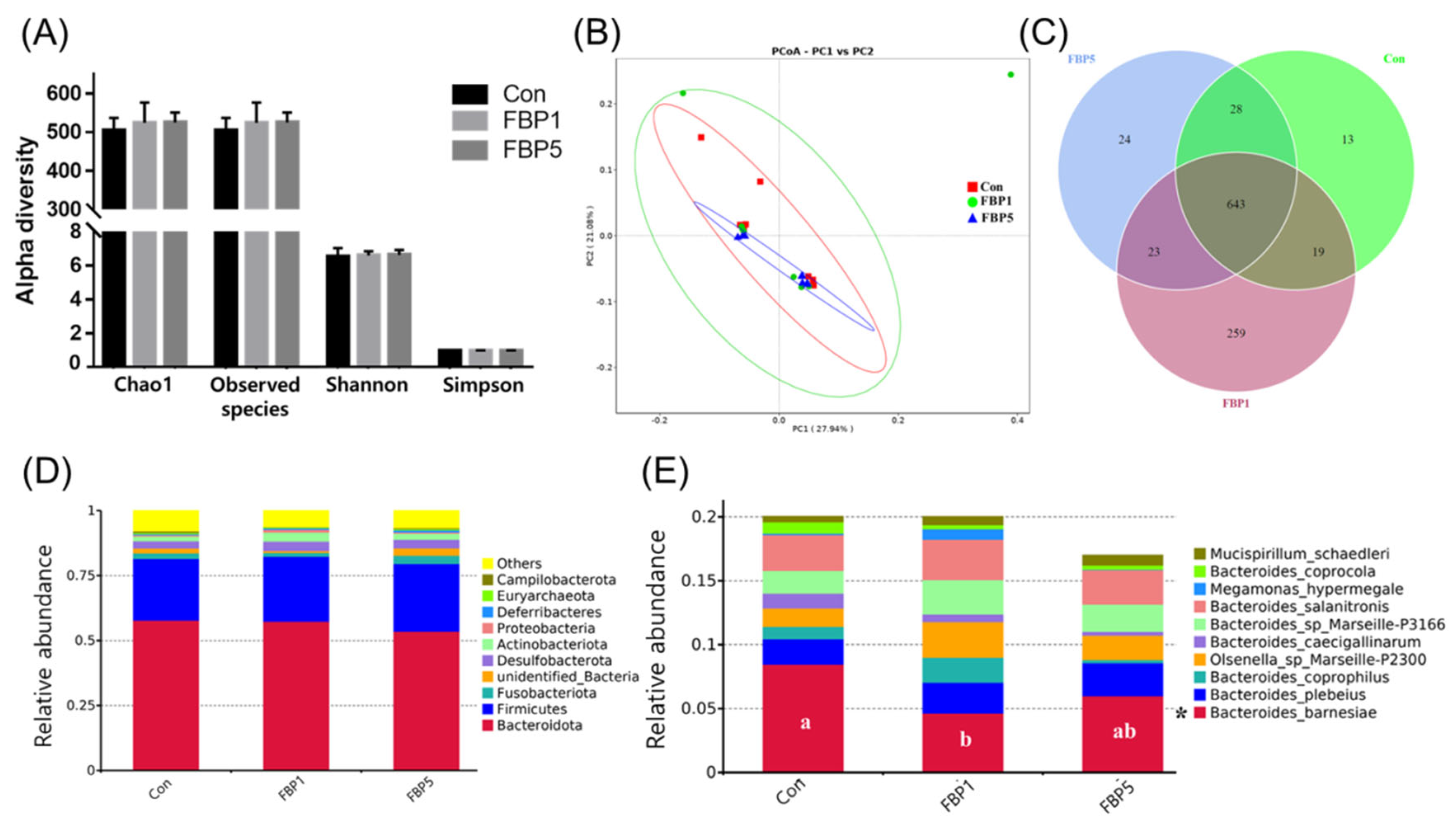Multi-Omics-Based Functional Characterization of Hybrid Fermented Broussonetia papyrifera: A Preliminary Study on Gut Health of Laying Hens
Abstract
1. Introduction
2. Materials and Methods
2.1. Microbes and Reagents
2.2. Selection of the Suitable Probiotic Strain for B. papyrifera Fermentation
2.3. Effects of Yeast By-Product (YB) Supplementation on B. papyrifera Fermentation
2.3.1. Proximate Composition
2.3.2. Functional Properties
2.4. Characterization of the Practical Fermented B. papyrifera
2.4.1. Bacterial Community Analysis
2.4.2. Metabolomics Analysis
2.5. Dietary Effects of Fermented B. papyrifera on Intestinal Health of Laying Hens
2.5.1. Serum Antioxidant Activity
2.5.2. Intestinal Morphology
2.5.3. Colonic Microbiota
2.5.4. Ileum Antioxidant-, Immune-, and Intestinal Barrier-Related Gene Expression
2.6. Statistical Analysis
3. Results
3.1. Suitable Fermentative Microbe for B. papyrifera Fermentation
3.2. Effects of Yeast By-Product (YB) Supplementation on B. papyrifera Fermentation
3.3. Characterization of the L. plantarum-Fermented B. papyrifera
3.4. Dietary Effects of Fermented B. papyrifera on Intestinal Health of Laying Hens
4. Discussion
5. Conclusions
Supplementary Materials
Author Contributions
Funding
Institutional Review Board Statement
Informed Consent Statement
Data Availability Statement
Conflicts of Interest
References
- Peng, X.; Liu, H.; Chen, P.; Tang, F.; Hu, Y.; Wang, F.; Pi, Z.; Zhao, M.; Chen, N.; Chen, H.; et al. A Chromosome-Scale Genome Assembly of Paper Mulberry (Broussonetia papyrifera) Provides New Insights into Its Forage and Papermaking Usage. Mol. Plant 2019, 12, 661–677. [Google Scholar] [CrossRef] [PubMed]
- Si, B.; Tao, H.; Zhang, X.; Guo, J.; Cui, K.; Tu, Y.; Diao, Q. Effect of Broussonetia papyrifera L. (paper mulberry) silage on dry matter intake, milk composition, antioxidant capacity and milk fatty acid profile in dairy cows. Asian Australas. J. Anim. Sci. 2018, 31, 1259–1266. [Google Scholar] [CrossRef] [PubMed]
- Peng, X.J.; Teng, L.H.; Wang, X.M.; Wang, Y.C.; Shen, S.H. De Novo assembly of expressed transcripts and global transcriptomic analysis from seedlings of the paper mulberry (Broussonetia kazinoki x Broussonetia papyifera). PLoS ONE 2014, 9, e97487. [Google Scholar]
- Du, Z.; Sun, L.; Chen, C.; Lin, J.; Yang, F.; Cai, Y. Exploring microbial community structure and metabolic gene clusters during silage fermentation of paper mulberry, a high-protein woody plant. Anim. Feed Sci. Technol. 2020, 275, 114766. [Google Scholar] [CrossRef]
- Dong, L.; Zhang, H.; Gao, Y.; Diao, Q. Dynamic profiles of fermentation characteristics and bacterial community composition of Broussonetia papyrifera ensiled with perennial ryegrass. Bioresour. Technol. 2020, 310, 123396. [Google Scholar] [CrossRef]
- Tao, H.; Si, B.; Xu, W.; Tu, Y.; Diao, Q. Effect of Broussonetia papyrifera L. silage on blood biochemical parameters, growth performance, meat amino acids and fatty acids compositions in beef cattle. Asian-Australas. J. Anim. Sci. 2020, 33, 732–741. [Google Scholar] [CrossRef]
- Muck, R.E.; Nadeau, E.M.G.; McAllister, T.A.; Contreras-Govea, F.E.; Santos, M.C.; Kung, L., Jr. Silage review: Recent advances and future uses of silage additives. J. Dairy Sci. 2018, 101, 3980–4000. [Google Scholar] [CrossRef]
- Zhang, Q.; Yu, Z.; Wang, X. Isolating and evaluating lactic acid bacteria strains with or without sucrose for effectiveness of silage fermentation. Grassl. Sci. 2015, 61, 167–176. [Google Scholar] [CrossRef]
- Ni, K.; Wang, F.; Zhu, B.; Yang, J.; Zhou, G.; Pan, Y.; Tao, Y.; Zhong, J. Effects of lactic acid bacteria and molasses additives on the microbial community and fermentation quality of soybean silage. Bioresour. Technol. 2017, 238, 706–715. [Google Scholar] [CrossRef]
- Nishino, N.; Li, Y.; Wang, C.; Parvin, S. Effects of wilting and molasses addition on fermentation and bacterial community in guinea grass silage. Lett. Appl. Microbiol. 2012, 54, 175–181. [Google Scholar] [CrossRef]
- Wang, Y.; Chen, X.; Wang, C.; He, L.; Zhou, W.; Yang, F.; Zhang, Q. The bacterial community and fermentation quality of mulberry (Morus alba) leaf silage with or without Lactobacillus casei and sucrose. Bioresour. Technol. 2019, 293, 122059. [Google Scholar] [CrossRef] [PubMed]
- Wang, N.; Xiong, Y.; Wang, X.; Guo, L.; Lin, Y.; Ni, K.; Yang, F. Effects of Lactobacillus plantarum on Fermentation Quality and Anti-Nutritional Factors of Paper Mulberry Silage. Fermentation 2022, 8, 144. [Google Scholar] [CrossRef]
- Wang, W.; Hao, Y.; Luo, C.; Wang, Q.; Wang, Z.; Li, D.; Yuan, J.; Cao, Z.; Yang, H.; Li, S. Effects of Different Additives on the Chemical Composition, Fermentation Profile, In Vitro and In Situ Digestibility of Paper mulberry Silage. Fermentation 2022, 8, 435. [Google Scholar] [CrossRef]
- Han, Q.; Wu, Z.; Huang, B.; Sun, L.; Ding, C.; Yuan, S.; Zhang, Z.; Chen, Y.; Hu, C.; Zhou, L.; et al. Extraction, antioxidant and antibacterial activities of Broussonetia papyrifera fruits polysaccharides. Int. J. Biol. Macromol. 2016, 92, 116–124. [Google Scholar] [CrossRef] [PubMed]
- Ko, H.-H.; Chang, W.-L.; Lu, T.-M. Antityrosinase and Antioxidant Effects of ent-Kaurane Diterpenes from Leaves of Broussonetia papyrifera. J. Nat. Prod. 2008, 71, 1930–1933. [Google Scholar] [CrossRef] [PubMed]
- Ryu, H.W.; Curtis-Long, M.J.; Jung, S.; Jeong, I.Y.; Kim, D.S.; Kang, K.Y.; Park, K.H. Anticholinesterase potential of flavonols from paper mulberry (Broussonetia papyrifera) and their kinetic studies. Food Chem. 2012, 132, 1244–1250. [Google Scholar] [CrossRef]
- Li, Z.; Feng, C.; Luo, X.; Yao, H.; Zhang, D.; Zhang, T. Revealing the influence of microbiota on the quality of Pu-erh tea during fermentation process by shotgun metagenomic and metabolomic analysis. Food Microbiol. 2018, 76, 405–415. [Google Scholar] [CrossRef]
- Long, P.; Wen, M.; Granato, D.; Zhou, J.; Wu, Y.; Hou, Y.; Zhang, L. Untargeted and targeted metabolomics reveal the chemical characteristic of pu-erh tea (Camellia assamica) during pile-fermentation. Food Chem. 2019, 311, 125895. [Google Scholar] [CrossRef]
- Tian, J.-L.; Liu, T.-L.; Xue, J.-J.; Hong, W.; Zhang, Y.; Zhang, D.-X.; Cui, C.-C.; Liu, M.-C.; Niu, S.-L. Flavanoids derivatives from the root bark of Broussonetia papyrifera as a tyrosinase inhibitor. Ind. Crops Prod. 2019, 138, 111445. [Google Scholar] [CrossRef]
- Niu, K.; Kothari, D.; Lee, W.; Lim, J.; Khosravi, S.; Lee, S.; Lee, B.; Kim, K.; Han, H.; Kim, S. Autochthonous Bacillus licheniformis: Probiotic potential and survival ability in low-fishmeal extruded pellet aquafeed. MicrobiologyOpen 2018, 8, e767. [Google Scholar] [CrossRef]
- Hao, Y.; Huang, S.; Liu, G.; Zhang, J.; Liu, G.; Cao, Z.; Wang, Y.; Wang, W.; Li, S. Effects of Different Parts on the Chemical Composition, Silage Fermentation Profile, in Vitro and in Situ Digestibility of Paper Mulberry. Animals 2021, 11, 413. [Google Scholar] [CrossRef] [PubMed]
- Niu, K.-M.; Kothari, D.; Cho, S.-B.; Han, S.-G.; Song, I.-G.; Kim, S.-C.; Kim, S.-K. Exploring the Probiotic and Compound Feed Fermentative Applications of Lactobacillus plantarum SK1305 Isolated from Korean Green Chili Pickled Pepper. Probiotics Antimicrob. Proteins 2018, 11, 801–812. [Google Scholar] [CrossRef] [PubMed]
- Ainsworth, E.A.; Gillespie, K.M. Estimation of total phenolic content and other oxidation substrates in plant tissues using Folin–Ciocalteu reagent. Nat. Protoc. 2007, 2, 875–877. [Google Scholar] [CrossRef] [PubMed]
- Herald, T.J.; Gadgil, P.; Tilley, M. High-throughput micro plate assays for screening flavonoid content and DPPH-scavenging activity in sorghum bran and flour. J. Sci. Food Agric. 2012, 92, 2326–2331. [Google Scholar] [CrossRef]
- Niu, K.-M.; Khosravi, S.; Kothari, D.; Lee, W.-D.; Lim, J.-M.; Lee, B.-J.; Kim, K.-W.; Lim, S.-G.; Lee, S.-M.; Kim, S.-K. Effects of dietary multi-strain probiotics supplementation in a low fishmeal diet on growth performance, nutrient utilization, proximate composition, immune parameters, and gut microbiota of juvenile olive flounder (Paralichthys olivaceus). Fish Shellfish Immunol. 2019, 93, 258–268. [Google Scholar] [CrossRef]
- Choe, D.W.; Loh, T.C.; Foo, H.L.; Hair-Bejo, M.; Awis, Q.S. Egg production, faecal pH and microbial population, small intestine morphology, and plasma and yolk cholesterol in laying hens given liquid metabolites produced by Lactobacillus plantarum strains. Brit. Poultry Sci. 2012, 53, 106–115. [Google Scholar] [CrossRef]
- Zhang, Y.C.; Li, D.X.; Wang, X.K.; Lin, Y.L.; Zhang, Q.; Chen, X.Y.; Yang, F.Y. Fermentation dynamics and diversity of bacterial community in four typical woody forages. Ann. Microbiol. 2019, 69, 233–240. [Google Scholar] [CrossRef]
- Li, R.; Zheng, M.; Jiang, D.; Tian, P.; Zheng, M.; Xu, C. Replacing Alfalfa with Paper Mulberry in Total Mixed Ration Silages: Effects on Ensiling Characteristics, Protein Degradation, and In Vitro Digestibility. Animals 2021, 11, 1273. [Google Scholar] [CrossRef]
- Agarussi, M.C.N.; Pereira, O.G.; De Paula, R.A.; Da Silva, V.P.; Roseira, J.P.S.; Silva, F.F.E. Novel lactic acid bacteria strains as inoculants on alfalfa silage fermentation. Sci. Rep. 2019, 9, 8007. [Google Scholar] [CrossRef]
- Yitbarek, M.B.; Tamir, B. Silage Additives: Review. Open J. Appl. Sci. 2014, 4, 258–274. [Google Scholar] [CrossRef]
- Arif, M.; Alagawany, M.; Abd El-Hack, M.E.; Saeed, M.; Arain, M.A.; Elnesr, S.S. Humic acid as a feed additive in poultry diets: A review. Iran. J. Vet. Res. 2019, 20, 167–172. [Google Scholar] [CrossRef] [PubMed]
- Sohn, H.Y.; Kwon, C.S.; Son, K.H. Fungicidal Effect of Prenylated Flavonol, Papyriflavonol A, Isolated from Broussonetia papyrifera (L.) Vent. Against Candida albicans. J. Microbiol. Biotechnol. 2010, 20, 1397–1402. [Google Scholar] [CrossRef] [PubMed]
- Hur, S.J.; Lee, S.Y.; Kim, Y.-C.; Choi, I.; Kim, G.-B. Effect of fermentation on the antioxidant activity in plant-based foods. Food Chem. 2014, 160, 346–356. [Google Scholar] [CrossRef] [PubMed]
- You, L.; Bao, W.; Yao, C.; Zhao, F.; Jin, H.; Huang, W.; Li, B.; Kwok, L.-Y.; Liu, W. Changes in chemical composition, structural and functional microbiome during alfalfa (Medicago sativa) ensilage with Lactobacillus plantarum PS-8. Anim. Nutr. 2022, 9, 100–109. [Google Scholar] [CrossRef]
- Yang, L.; Yuan, X.; Li, J.; Dong, Z.; Shao, T. Dynamics of microbial community and fermentation quality during ensiling of sterile and nonsterile alfalfa with or without Lactobacillus plantarum inoculant. Bioresour. Technol. 2018, 275, 280–287. [Google Scholar] [CrossRef]
- Méndez-García, C.; Peláez, A.I.; Mesa, V.; Sánchez, J.; Golyshina, O.V.; Ferrer, M. Microbial diversity and metabolic networks in acid mine drainage habitats. Front. Microbiol. 2015, 6, 475. [Google Scholar] [CrossRef]
- McElhiney, J.; Lawton, L.A.; Leifert, C. Investigations into the inhibitory effects of microcystins on plant growth, and the toxicity of plant tissues following exposure. Toxicon 2001, 39, 1411–1420. [Google Scholar] [CrossRef]
- Khan, A.L.; Waqas, M.; Asaf, S.; Kamran, M.; Shahzad, R.; Bilal, S.; Khan, M.A.; Kang, S.-M.; Kim, Y.-H.; Yun, B.-W.; et al. Plant growth-promoting endophyte Sphingomonas sp. LK11 alleviates salinity stress in Solanum pimpinellifolium. Environ. Exp. Bot. 2016, 133, 58–69. [Google Scholar] [CrossRef]
- Ogunade, I.M.; Jiang, Y.; Cervantes, A.A.P.; Kim, D.H.; de Oliveira, A.S.; Vyas, D.; Weinberg, Z.G.; Jeong, K.C.; Adesogan, A.T. Bacterial Diversity and Composition of Alfalfa Silage as Analyzed by Illumina MiSeq Sequencing: Effects of Escherichia coli O157:H7 and Silage Additives. J. Dairy Sci. 2018, 101, 2048–2059. [Google Scholar] [CrossRef]
- Ogunade, I.M.; Jiang, Y.; Kim, D.H.; Cervantes, A.A.P.; Arriola, K.G.; Vyas, D.; Weinberg, Z.G.; Jeong, K.C.; Adesogan, A.T. Fate of Escherichia coil O157:H7 and bacterial diversity in corn silage contaminated with the pathogen and treated with chemical or microbial additives. J. Dairy Sci. 2017, 100, 1780–1794. [Google Scholar] [CrossRef]
- Xu, M.-L.; Wang, L.; Hu, J.-H.; Lee, S.K.; Wang, M.-H. Antioxidant activities and related polyphenolic constituents of the methanol extract fractions from Broussonetia papyrifera stem bark and wood. Food Sci. Biotechnol. 2010, 19, 677–682. [Google Scholar] [CrossRef]
- Filannino, P.; Di Cagno, R.; Gobbetti, M. Metabolic and functional paths of lactic acid bacteria in plant foods: Get out of the labyrinth. Curr. Opin. Biotechnol. 2018, 49, 64–72. [Google Scholar] [CrossRef] [PubMed]
- Bock, K.W. Aryl hydrocarbon receptor (AHR) functions: Balancing opposing processes including inflammatory reactions. Biochem. Pharmacol. 2020, 178, 114093. [Google Scholar] [CrossRef]
- Zhou, L. AHR Function in Lymphocytes: Emerging Concepts. Trends Immunol. 2015, 37, 17–31. [Google Scholar] [CrossRef]
- Vriend, J.; Reiter, R.J. The Keap1-Nrf2-antioxidant response element pathway: A review of its regulation by melatonin and the proteasome. Mol. Cell. Endocrinol. 2014, 401, 213–220. [Google Scholar] [CrossRef] [PubMed]
- Singh, R.; Chandrashekharappa, S.; Bodduluri, H.; Baby, B.V.; Hegde, B.; Kotla, N.G.; Hiwale, A.A.; Saiyed, T.; Patel, P.; Vijay-Kumar, M.; et al. Enhancement of the gut barrier integrity by a microbial metabolite through the Nrf2 pathway. Nat. Commun. 2019, 10, 89. [Google Scholar] [CrossRef]








| Characterization | Items 1 | CBP | FBP |
|---|---|---|---|
| General properties | pH | 6.7 ± 0.0 a | 4.6 ± 0.0 b |
| LAB cell count, log10 CFU/g | 5.6 ± 0.1 b | 6.9 ± 0.7 b | |
| Reducing sugar, mg/g | 1.5 ± 0.1 a | 0.71 ± 0.0 b | |
| Protein concentration, mg/g | 3.1 ± 0.4 a | 8.5 ± 1.0 b | |
| Proximate composition | DM, % | 47.9 ± 0.8 | 45.7 ± 4.9 |
| NDF, %DM | 42.2 ± 1.4 | 39.8 ± 5.8 | |
| CP, %DM | 18.4 ± 0.1 a | 18.8 ± 0.2 b | |
| CF, %DM | 9.8 ± 0.6 a | 8.7 ± 0.5 b | |
| Ash, %DM | 13.8 ± 0.3 | 14.2 ± 0.3 | |
| TE, kJ | 16.1 ± 0.5 | 16.7 ± 0.2 | |
| Total antioxidant activity | DPPH assay, mmol/L AAE/BPME mL | 0.71 ± 0.02 a | 0.67 ± 0.01 b |
| ABTS assay, mmol/L TE/BPME mL | 0.84 ± 0.04 a | 0.95 ± 0.01 b | |
| FRAP assay, mmol/L Fe2+/BPME mL | 0.83 ± 0.22 a | 1.34 ± 0.05 b | |
| Antioxidant compound contents | TFC, QE μg/mL BPME | 363.8 ± 46.2 a | 703.8 ± 68.6 b |
| TPC, GAE μg/mL BPME | 139.1 ± 2.7 a | 144.4 ± 1.2 b | |
| Antibacterial activity (clear zone diameter: mm) | E. coli O157:H7 | 0.0 ± 0.0 a | 21.0 ± 1.0 b |
| P. aeruginosa PAO1 | 0.0 ± 0.0 a | 20.0 ± 0.0 b | |
| S. aureus | 19.0 ± 1.0 a | 27.3 ± 0.6 b | |
| S. typhimurium | 0.0 ± 0.0 a | 21.7 ± 0.6 b |
| No. | Tentatively Identified Metabolites | MW | RT [min] | FC [T/C] | Class of Compounds |
|---|---|---|---|---|---|
| 1 | Apigenin | 270 | 11.77 | 3.34 | Flavone |
| 2 | Luteolin | 286 | 10.95 | 4.26 | Flavonoid |
| 3 | Diosmetin | 300 | 11.95 | 3.5 | Flavonoid |
| 4 | 16-Hydroxyhexadecanoic acid | 272 | 18.98 | 3.17 | Fatty acid |
| 5 | Acetylcholine | 145 | 1.24 | 7.17 | Vitamin |
| 6 | Caffeic acid | 180 | 7.86 | 6.49 | Phenolic acid |
| 7 | Quercetin | 302 | 10.99 | 3.14 | Flavonol |
| 8 | Leucylproline | 228 | 5.45 | 5.36 | Amino acid |
| 9 | 4-Hydroxybenzaldehyde | 122 | 12.30 | 2.04 | Aldehyde |
| 10 | 5-Hydroxymethyl-2-furaldehyde | 126 | 1.47 | -1.46 | Aldehyde |
| 11 | Alternariolmethylether | 272 | 11.45 | 2.77 | Ether |
| 12 | Taxifolin | 304 | 9.31 | 2.75 | Flavonoid |
| 13 | 3-Methyl-5-(5,5,8a-trimethyl-2-methylene-7-oxodecahydro-1-naphthalenyl)pentyl acetate | 348 | 20.05 | 2.35 | Ester |
| 14 | DL-Arginine | 174 | 1.18 | 2.27 | Amino acid |
| 15 | L-Ascorbic acid 2-sulfate | 256 | 2.63 | 4.46 | Vitamin |
| 16 | 1-Linoleoyl glycerol | 354 | 15.20 | −3.74 | Coumestan |
| 17 | Cytosine | 111 | 1.22 | 2.91 | Nucleotide |
| 18 | 3-Amino-2-naphthoic acid | 187 | 8.50 | 3.45 | Fatty acid |
| 20 | Emodin | 270 | 10.60 | 2.86 | Anthraquinone |
| 21 | 10-Propoxydecanoic acid | 230 | 15.66 | 1.06 | Fatty acid |
| 22 | DL-Lysine | 146 | 1.08 | 2.16 | Amino acid |
| 23 | N8-Acetylspermidine | 187 | 1.16 | 2.82 | Amine |
| 24 | Docosahexaenoic acid (DHA) | 328 | 16.55 | 1.14 | Fatty acid |
Publisher’s Note: MDPI stays neutral with regard to jurisdictional claims in published maps and institutional affiliations. |
© 2022 by the authors. Licensee MDPI, Basel, Switzerland. This article is an open access article distributed under the terms and conditions of the Creative Commons Attribution (CC BY) license (https://creativecommons.org/licenses/by/4.0/).
Share and Cite
Niu, K.; Khosravic, S.; Wang, Y.; Zhai, Z.; Wang, R.; Liu, J.; Cai, L.; Li, J.; Deng, L.; Wu, X. Multi-Omics-Based Functional Characterization of Hybrid Fermented Broussonetia papyrifera: A Preliminary Study on Gut Health of Laying Hens. Fermentation 2022, 8, 547. https://doi.org/10.3390/fermentation8100547
Niu K, Khosravic S, Wang Y, Zhai Z, Wang R, Liu J, Cai L, Li J, Deng L, Wu X. Multi-Omics-Based Functional Characterization of Hybrid Fermented Broussonetia papyrifera: A Preliminary Study on Gut Health of Laying Hens. Fermentation. 2022; 8(10):547. https://doi.org/10.3390/fermentation8100547
Chicago/Turabian StyleNiu, Kaimin, Sanaz Khosravic, Yongfeng Wang, Zhenya Zhai, Ruxia Wang, Jianping Liu, Lichuang Cai, Jianxi Li, Liping Deng, and Xin Wu. 2022. "Multi-Omics-Based Functional Characterization of Hybrid Fermented Broussonetia papyrifera: A Preliminary Study on Gut Health of Laying Hens" Fermentation 8, no. 10: 547. https://doi.org/10.3390/fermentation8100547
APA StyleNiu, K., Khosravic, S., Wang, Y., Zhai, Z., Wang, R., Liu, J., Cai, L., Li, J., Deng, L., & Wu, X. (2022). Multi-Omics-Based Functional Characterization of Hybrid Fermented Broussonetia papyrifera: A Preliminary Study on Gut Health of Laying Hens. Fermentation, 8(10), 547. https://doi.org/10.3390/fermentation8100547






